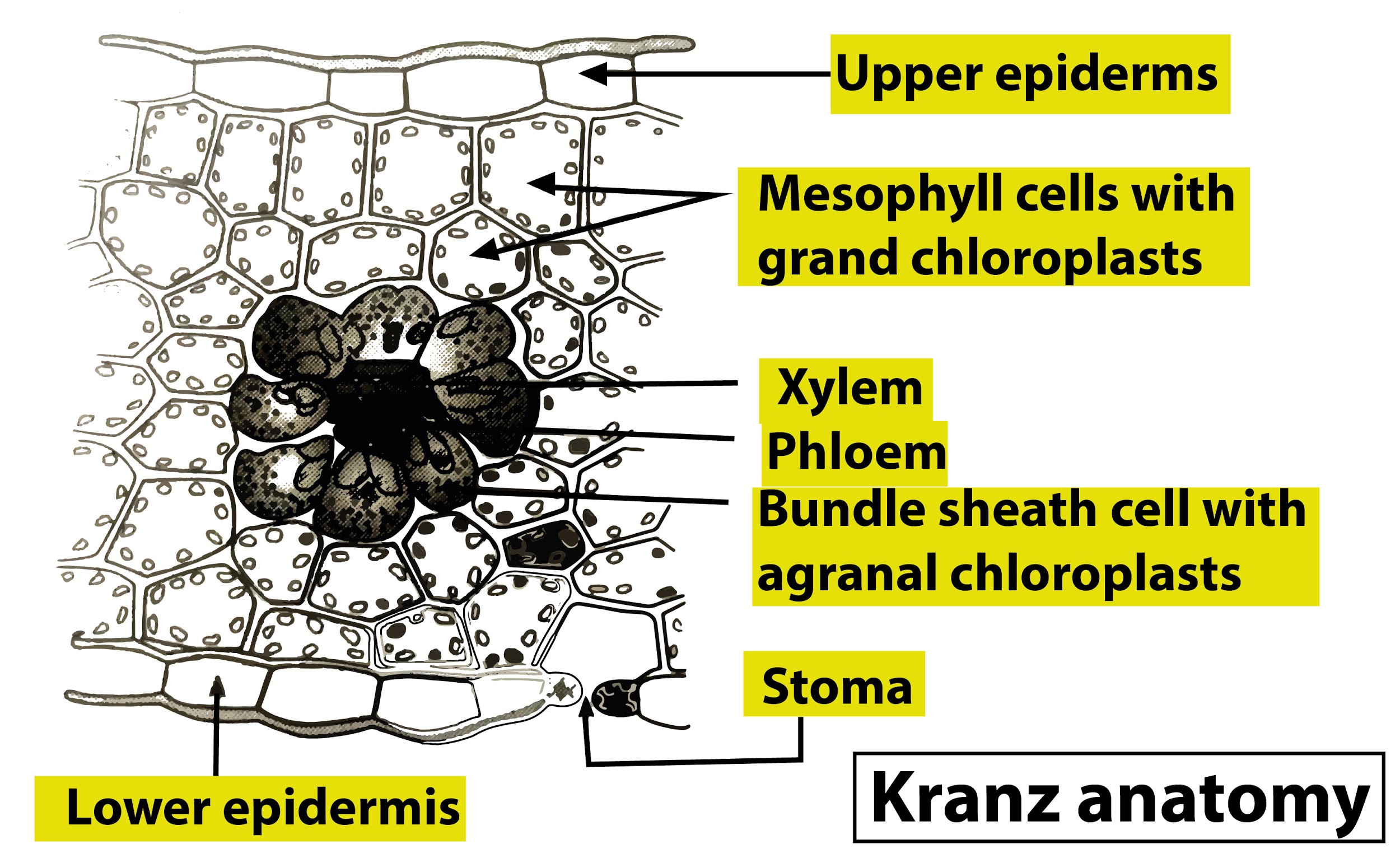
a)Thin walls, many intercellular spaces, and no chloroplasts
b)Thick walls, no intercellular spaces, and a large number of chloroplasts
c) Thin walls, no intercellular spaces, and several chloroplasts
d) Thick walls, much intercellular space,s and few chloroplasts
Answer
494.1k+ views
Hint: The word Kranz signifies "wreath" or "ring". Kranz life systems are a particular structure; it is an exceptional structure in the leaves of
Complete answer:
To the extent they realized their specific cytological qualities are basic for
Kranz cells are normally viewed as limited to a parenchyma sheath encompassing vascular groups of the leaf. Sheaths encompassing vascular packs in leaves are ordinary of both mono-and dicotyledons, consisting by and large of cells stretched corresponding to the hub of the group.
Additional Information: - In the Gramineae and Cyperaceae there are fundamentally two concentric and adjoining sheaths, an inward mestome sheath of little, thick-walled, chlorophyll-lacking cells and an external parenchyma sheath of thick or meager walled cells, with not many to various chloroplasts, and of cell sizes from normal to very huge. In dicots, there is generally just the parenchyma.
- The mestome sheath likely creates from procambium, though the parenchyma sheath is gotten from the beginning. It is commonly accepted that the parenchyma sheath cells of some non-Kranz species have developed into the Kranz cells of most non-CAM species having
So the correct answer is’ Thick walls, no intercellular spaces and a large number of chloroplasts’.

Note: - It is presently obvious that all Kranz cells and sheaths are not changed parenchyma sheaths and parenchyma sheath cells, despite the fact that they regularly are. Nor are Kranz cells consistently related by contact with mesophyll cells. Nor are they in every case firmly connected with vascular tissue. They might be inner or outside to a mestome sheath, or they might be simply the mestome sheath.
- They can get physically involved with xylem, phloem, sclerenchyma, dreary parenchyma, parenchyma sheath, mestome sheath, another Kranz sheath, just as mesophyll, and even epidermis partially. Accordingly, they can work anyplace inside the leaf and in relationship with practically any leaf tissue, however quite often inward to some mesophyll.
Complete answer:
To the extent they realized their specific cytological qualities are basic for
Kranz cells are normally viewed as limited to a parenchyma sheath encompassing vascular groups of the leaf. Sheaths encompassing vascular packs in leaves are ordinary of both mono-and dicotyledons, consisting by and large of cells stretched corresponding to the hub of the group.
Additional Information: - In the Gramineae and Cyperaceae there are fundamentally two concentric and adjoining sheaths, an inward mestome sheath of little, thick-walled, chlorophyll-lacking cells and an external parenchyma sheath of thick or meager walled cells, with not many to various chloroplasts, and of cell sizes from normal to very huge. In dicots, there is generally just the parenchyma.
- The mestome sheath likely creates from procambium, though the parenchyma sheath is gotten from the beginning. It is commonly accepted that the parenchyma sheath cells of some non-Kranz species have developed into the Kranz cells of most non-CAM species having
So the correct answer is’ Thick walls, no intercellular spaces and a large number of chloroplasts’.

Note: - It is presently obvious that all Kranz cells and sheaths are not changed parenchyma sheaths and parenchyma sheath cells, despite the fact that they regularly are. Nor are Kranz cells consistently related by contact with mesophyll cells. Nor are they in every case firmly connected with vascular tissue. They might be inner or outside to a mestome sheath, or they might be simply the mestome sheath.
- They can get physically involved with xylem, phloem, sclerenchyma, dreary parenchyma, parenchyma sheath, mestome sheath, another Kranz sheath, just as mesophyll, and even epidermis partially. Accordingly, they can work anyplace inside the leaf and in relationship with practically any leaf tissue, however quite often inward to some mesophyll.
Recently Updated Pages
Master Class 9 General Knowledge: Engaging Questions & Answers for Success

Master Class 9 English: Engaging Questions & Answers for Success

Master Class 9 Science: Engaging Questions & Answers for Success

Master Class 9 Social Science: Engaging Questions & Answers for Success

Master Class 9 Maths: Engaging Questions & Answers for Success

Class 9 Question and Answer - Your Ultimate Solutions Guide

Trending doubts
Give 10 examples of unisexual and bisexual flowers

Draw a labelled sketch of the human eye class 12 physics CBSE

Differentiate between homogeneous and heterogeneous class 12 chemistry CBSE

Differentiate between insitu conservation and exsitu class 12 biology CBSE

What are the major means of transport Explain each class 12 social science CBSE

Why is the cell called the structural and functional class 12 biology CBSE




